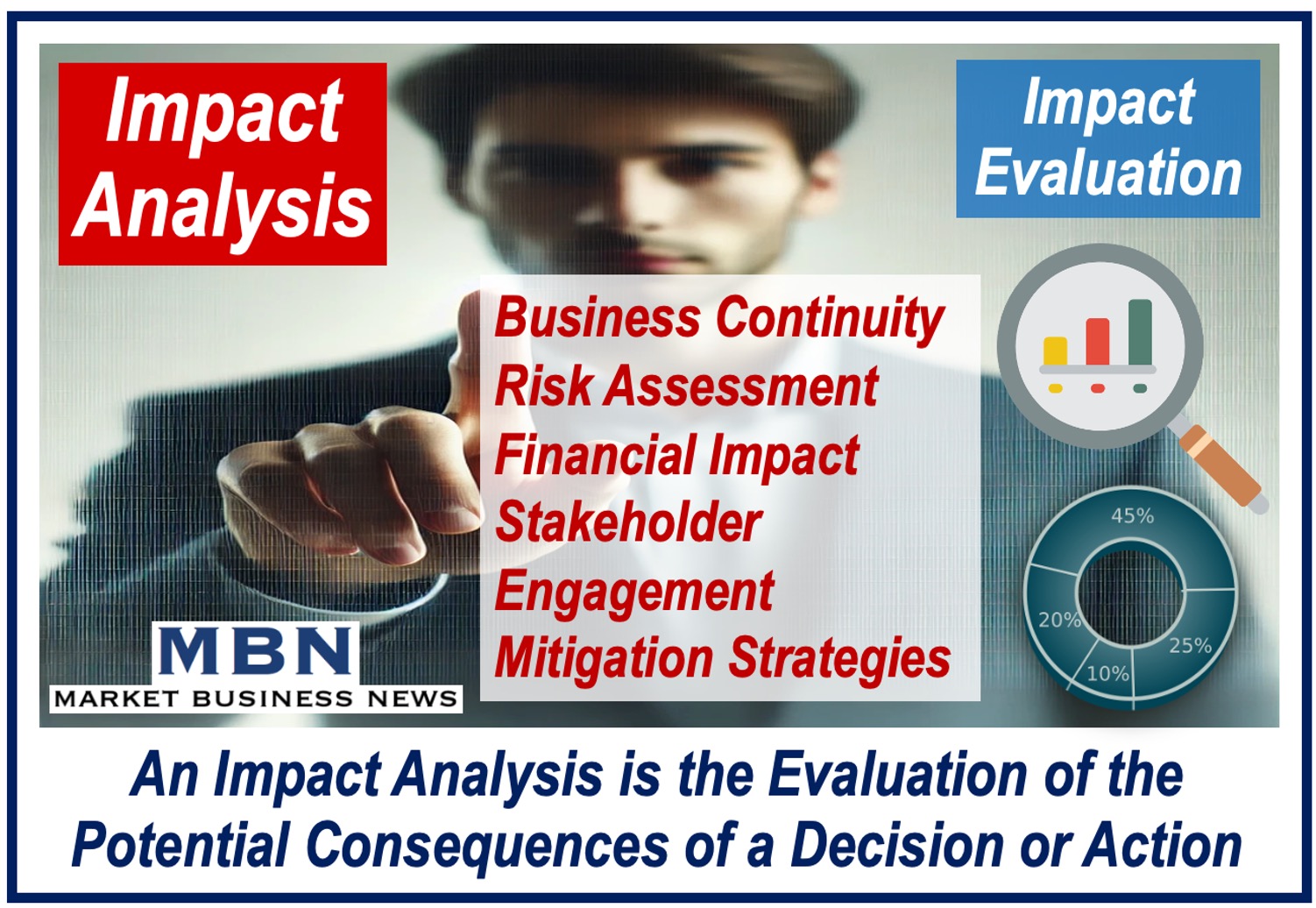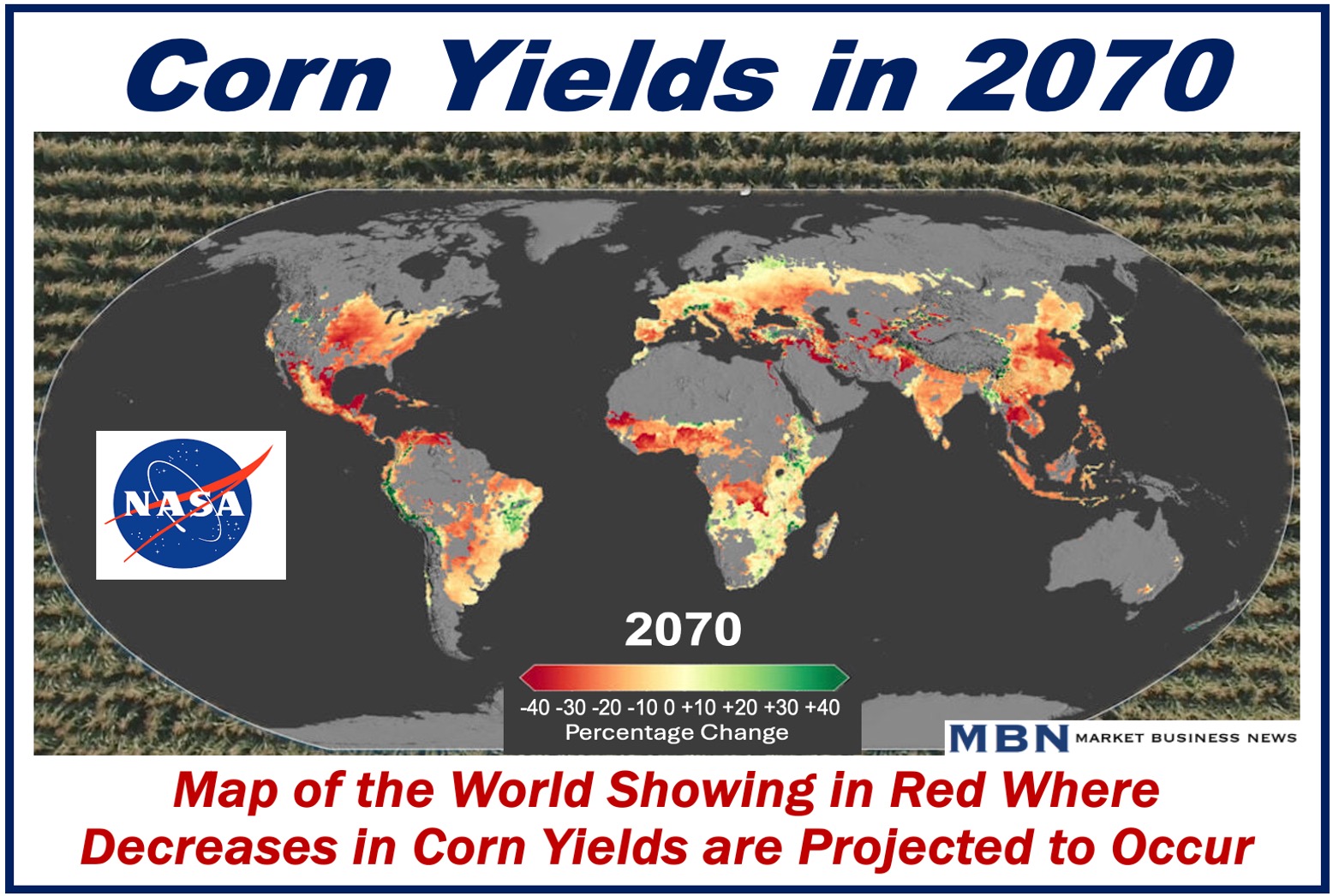Do you ever try to determine what the potential positive or negative consequences of a business decision were or might be? If you do, you practice Impact Analysis or Change Impact Analysis.
In the world of business, we might carry out an impact analysis regarding an unplanned disruptive event such as a hurricane, loss of data, strike, economic embargo, or supply chain breakdown.
Impact analysis is a comprehensive undertaking: it is a step-by-step process to determine what could potentially change, how people or your company might react, and how the market could change.
When the analysis is done by a business, about a company, or about the marketplace, we can call it a Business Impact Analysis or BIA.
Ready.gov, an official website of the U.S. Department of Homeland Security, says:
“A business impact analysis (BIA) predicts the consequences of a disruption to your business, and gathers information needed to develop recovery strategies. The BIA should identify the operational and financial impacts resulting from the disruption of business. It should prioritize the order of events for restoring business functions. Business processes with the greatest operational and financial impacts should be restored first.”
Main Functions of a Business Impact Analysis (BIA)
A BIA helps identify critical factors that enable your business to thrive and survive through unexpected events and disruptions. Let’s take a look at these factors:
-
Identification of Critical Functions
Identify key business processes and operations essential to your company’s survival and continuity.
-
Determination of Resource Requirements
Identify the resources, such as personnel, technology, data, facilities, etc., required to support critical functions.
-
Impact Assessment
Assess what impact a disruption might have on how your business operates, its finances, and regulatory compliance.
-
Recovery Prioritization and Timeframes
Establish the priority of business functions and acceptable recovery time objectives (RTOs).
-
Risk Assessment
Identify and evaluate potential risks or threats, such as cyberattacks, natural disasters (hurricanes, earthquakes, droughts, etc.), pandemics, supply chain disruptions, strikes, and power outages, that could harm your company or disrupt business activities.
-
Mitigation and Continuity Planning
Put forward suggestions or plans to minimize risks and their effects and maintain operations during a disruption.

Software Impact Analysis
When a programmer, developer, or tester alters a code, it will impact the system they are working on in some way. In best-case scenarios, the impact will be as expected or negligible.
They aim to implement the change so that it has the desired effect without any (significant) negative impact. To help ensure that happens, carrying out a software impact analysis is useful.
In an article published by QAREA, Anna Khrupa wrote:
“The point of doing software impact analysis is to help a tester or developer focus only on those areas that are influenced by a change or those tasks that are urgent and require instant fixes because of modifications. It is performed when there is a need for an improvement in a system or requirements.”
Government Impact Analysis
Apart from business leaders, heads of governments and policymakers also need to know what the potential consequences of a decision or event might be.
Without a Government Impact Analysis, it would be more difficult for them to make well-informed decisions.
Australia’s Department of the Prime Minister and Cabinet says the following about the Governments Impact Analysis Framework:
“The Government’s Impact Analysis Framework helps policymakers develop the evidence base for well-informed decision making. Almost every Government proposal being considered is within scope of the Government’s impact analysis requirements. The process and level of analysis required depends on the significance and impact of the proposal.”
Economic Impact Analysis (EIA)
This type of analysis is carried out to determine how an event, project, or policy might affect the economy regarding business or GDP growth, an industry, income, employment, and regional economic development.
Before pursuing an EIA, Virginia Polytechnic Institute and State University says that you should consider the following key questions:
“What is the ultimate purpose of the study? How will you use the findings? What is the scale of the impact (i.e. the size of the economy you are studying)? The larger the scale, the more difficult it is to effectively measure economic impact.
“Does the size of the activity relative to the size of the economy justify exploring the activity’s impacts? Will it have enough ripple effects? Is this study examining a one-time event or a larger industry change in your economy? Are you interested only in the dollar impact, or are there other impacts you need to explore?”
Climate Impact Analysis
With this type of analysis, your aim is to evaluate the potential impact on projects, policies, or decisions on climate change, assessing how energy use, emissions, and environmental changes might contribute to or minimize global climate change.
It helps organizations and governments determine the sustainability of their actions in relation to global climate goals.
- NASA Study
In 2021, NASA conducted a climate change analysis that focused on the impact of climate change on global crop yields.
NASA researchers determined how rising global temperatures, changing rainfall patterns, and rising CO2 levels would affect crops like wheat and maize (corn) by 2030.
According to the study, there will probably be significant decline in maize yields in the tropical regions of the world. Wheat yields, on the other hand, may increase in temperate regions.

The researchers, who published their study and findings in the prestigious, peer-reviewed journal Nature Food, said that while growing maize in the tropics might become more difficult, wheat’s growing range could expand.
Lead author Jonas Jägermeyr, a crop modeler and climate scientist at NASA’s Goddard Institute for Space Studies (GISS) and The Earth Institute at Columbia University in New York City, said:
“We did not expect to see such a fundamental shift, as compared to crop yield projections from the previous generation of climate and crop models conducted in 2014. A 20% decrease from current production levels could have severe implications worldwide.”
Health Impact Analysis (HIA)
If you want to determine what the effects of a proposed project, decision, or policy might be on the public’s physical or mental health, you will carry out a Health Impact Analysis.
HIA helps policymakers and decision-makers select options that are not likely to harm human health.
The World Health Organization, which refers to it as a Health Impact Assessment, describes HIA as a “practical approach used to systematically judge the potential health effects of a policy, strategy, plan, program or project on a population, particularly on vulnerable or disadvantaged groups.”
-
UK Study
Public Health England, an executive agency of the Department of Health and Social Care in England, released a guide in 2020 on the use of Health Impact Assessments in *spatial planning.
* Spatial planning is the organized management of land use to optimize sustainability and development. It takes into account several factors, including the economy, environment, and society.
This assessment focused on optimizing health and wellbeing outcomes in urban planning and local development.
The authors of the guide emphasized incorporating health consideration in the early phases of the planning process for local authorities. This is especially important when making decisions about transport, public spaces, and housing, they added.
The aim of this HIA was to ensure that the planning policies and developments reduces health inequalities, promoted healthier living environments, and enhance public wellbeing.
In a Foreword of the report, Professor John Newton, Director of Health Improvement at Public Health England, wrote:
“HIA is a tool used to identify the health impacts of a plan or project and to develop recommendations to maximize the positive impacts and minimize the negative impacts, while maintaining a focus on addressing health inequalities. By bringing such health considerations to the fore, HIAs add value to the planning process.”
Product Impact Analysis (PIA)
As the name indicates, a PIA assesses the impact of a new product on various factors, including the market, consumers, supply chains, production processes, societal wellbeing, and the environment.
It focuses on understanding the product’s life cycle, from raw material sourcing to manufacturing, distribution, and disposal, often aiming to measure sustainability and consumer safety impacts.
Since the turn of the century, as people have become more concerned about global warming, a typical PIA also considers the environmental footprint of the product.
-
M-Pesa Mobile Payment Platform
Safaricom carried out a product impact analysis for its M-Pesa mobile payment platform as part of a KPMG True Value Case Study.
The company measured the impact of providing secure financial connectivity to its customers, highlighting the increase in personal savings due to lower transaction costs and reduced theft.
The researchers quantified the positive social and economic effect of M-Pesa on its customers, particularly those living in low-income and rural areas, showcasing how the product improved financial security and accessibility for millions of people.
Other types of Impact Analysis
Apart from Business Impact Analysis (BIA), Software Impact Analysis, and Government Impact Analysis, there are several other major types of impact analyss. Let’s have a look at eight of them:
- Environmental Impact Analysis (EIA)
This type focuses on assessing the potential environmental consequences of projects, policies, or actions, commonly required by government regulations before large-scale development projects.
The Government of Scotland says the following about EIAs:
“EIAs make sure that project decision makers think about the likely effects on the environment at the earliest possible time and aim to avoid, reduce or offset those effects. This ensures that proposals are understood properly before decisions are made.”
- Social Impact Analysis (SIA)
Evaluates the effects of policies, programs, or projects on social factors like community wellbeing, population displacement, access to education, employment opportunities, income distribution, and social structures.
Wikipedia explains that SIA techniques can be used to evaluate the social impact of unexpected or unplanned events, such as epidemics/pandemics, natural disasters, and demographic change.
- Market Impact Analysis (MIA)
This type focuses on how a merger, innovative product, new regulation, change in consumer behavior, technological advancement, or global trade policy might affect market forces (supply and demand), competition, pricing, or business conditions in the marketplace.
In this case, make sure you only use the short form ‘MIA’ when the meaning is not ambiguous. MIA can also mean ‘missing in action.’
- Privacy Impact Analysis (PIA)
How might a new policy or planned project affect people’s privacy rights, especially if they are related to the gathering, storage, and use of personal data? If you want to find out, you will need to carry out a Privacy Impact Analysis.
- Regulatory Impact Analysis (RIA)
An RIA analyzes the potential effects of a new regulation on different *stakeholders, often to ensure that the benefits of the regulation justify its costs.
* Stakeholders are people who have an interest in a company or organization. The stakeholders of a company include its employees, suppliers, shareholders, customers, investors, government agencies, local communities, business partners, creditors, and regulatory bodies.
- Technology Impact Analysis (TIA)
Focuses on the potential consequences of adopting or changing technology, looking at how it will affect operations, security, and business processes.
- Supply Chain Impact Analysis (SCIA)
This type assesses how changes, disruptions, or decisions (such as sourcing new suppliers or changes in transportation) might impact the *supply chain, inventory, and logistics.
* The supply chain is the whole process of manufacturing/creating and selling commercial products. It includes every stage, from the supply of raw materials to delivering the final product to the ultimate consumer.
- Cultural Impact Analysis (CIA)
If you want to determine how a decision, project, new policy, or action might affect traditions, community identity, or cultural heritage, you will carry out a cultural impact analysis or cultural impact study.
A CIA may be ordered if the government, local authorities, or a company is planning a major tourism project.
